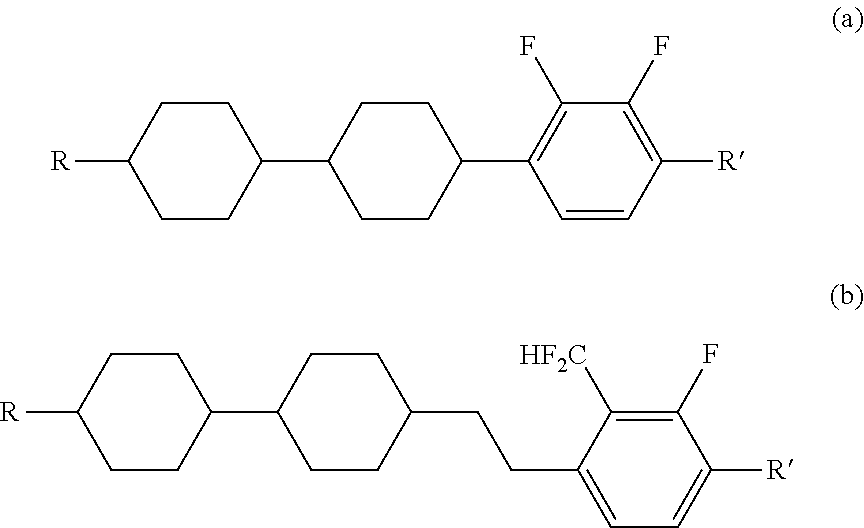Carbonyl derivative, liquid crystal composition containing compound thereof and liquid crystal display device
a liquid crystal display device and carbonyl derivative technology, applied in the direction of instruments, organic chemistry, chemistry apparatus and processes, etc., can solve the problems of shortening the service life of the device and reducing the electric power consumption of the device, and achieves high clearing point, small viscosity, and high heat resistance.
- Summary
- Abstract
- Description
- Claims
- Application Information
AI Technical Summary
Benefits of technology
Problems solved by technology
Method used
Image
Examples
example 1
Synthesis of Compound (1-1-2)
[0255]
First Step
[0256]In a reaction vessel, 4-bromo-2-fluorophenol (t-1) (48 g, 252 mmol), potassium carbonate (69.6 g, 504 mmol), tetrabutylammonium bromide (TBAB; 4.07 g, 12.6 mmol) and N,N-dimethylformamide (DMF; 400 mL) were put. Ethyl iodide (78.6 g, 504 mmol) was slowly added dropwise thereto at room temperature, and then the resulting mixture was stirred at room temperature for 5 hours. The resulting reaction mixture was poured into saturated brine, and subjected to extraction with hexane. Organic layers combined were washed with water and saturated brine, and dried over anhydrous sodium sulfate. The resulting solution was concentrated under reduced pressure, and the residue was purified by distillation under reduced pressure to give compound (t-2) (49.6 g, 226 mmol; 89.7%).
Second Step
[0257]Under a nitrogen atmosphere, compound (t-2) (40 g, 182.6 mmol) obtained in the first step and THF (600 mL) were put in a reaction vessel, and then cooled to −7...
example 2
Synthesis of Compound (1-2-1)
[0264]
First Step
[0265]Compound (t-7) (g, mmol; %) was obtained by performing operations in a manner similar to the operations in the fourth step in Example 1, using compound (t-4) (g, mmol) obtained in the third step in Example 1, THF (55 mL), a THF solution (1.3 M, mL, mmol) of isopropylmagnesium bromide and lithium chloride, and aldehyde (t-6) (g, mmol).
Second Step
[0266]Object compound (1-2-1) (g, mmol; %) was obtained by performing operations in a manner similar to the operations in the fifth step in Example 1, using compound (t-7) (g, mmol) obtained in the first step, dichloromethane (60 mL) and Dess-Martin periodinane (DMP; g, mmol).
[0267]1H-NMR (CDCl3) δ 7.42 (d, 1H), 7.25 (t, 1H; CF2H, J=53.3), 7.04 (t, 1H), 4.17 (q, 2H), 2.75 (d, 2H), 1.91-1.72 (m, 5H), 1.51 (t, 3H), 1.37-1.12 (m, 4H), 1.02-0.91 (m, 4H), 0.86 (t, 3H).
[0268]Physical properties of compound (1-2-1) were as described below.
[0269]Phase transition temperature: C 61.0 I.
Maximum temperat...
example 3
Synthesis of Compound (1-4-1)
[0270]
First Step
[0271]Compound (t-11) (2.12 g, 4.52 mmol; 33.1%) was obtained by performing operations in a manner similar to the operations in the fourth step in Example 1, using compound (t-4) (4.78 g, 17.74 mmol) obtained in the third step of Example 1, THF (80 mL), a THF solution (1.3 M, 13.64 mL, 17.74 mmol) of isopropylmagnesium bromide and lithium chloride, and aldehyde (t-10) (3.8 g, 13.64 mmol).
Second Step
[0272]Object compound (1-4-1) (0.74 g, 1.59 mmol; 70.1%) was obtained by performing operations in a manner similar to the operations in the fifth step in Example 1, using compound (t-11) (1.06 g, 2.26 mmol) obtained in the first step, dichloromethane (15 mL) and Dess-Martin periodinane (DMP; 1.44 g, 3.39 mmol).
[0273]1H-NMR (CDCl3) δ 7.43 (d, 1H), 7.39 (t, 1H; CF2H, J=53.3), 7.04 (t, 1H), 4.16 (q, 2H), 2.86 (t, 2H), 1.76-1.66 (m, 6H), 1.51 (t, 3H), 1.28-1.11 (m, 8H), 1.01-0.82 (m, 13H).
[0274]Physical properties of compound (1-4-1) were as descri...
PUM
| Property | Measurement | Unit |
|---|---|---|
| temperature | aaaaa | aaaaa |
| temperature | aaaaa | aaaaa |
| transition temperature | aaaaa | aaaaa |
Abstract
Description
Claims
Application Information
 Login to View More
Login to View More - R&D
- Intellectual Property
- Life Sciences
- Materials
- Tech Scout
- Unparalleled Data Quality
- Higher Quality Content
- 60% Fewer Hallucinations
Browse by: Latest US Patents, China's latest patents, Technical Efficacy Thesaurus, Application Domain, Technology Topic, Popular Technical Reports.
© 2025 PatSnap. All rights reserved.Legal|Privacy policy|Modern Slavery Act Transparency Statement|Sitemap|About US| Contact US: help@patsnap.com



